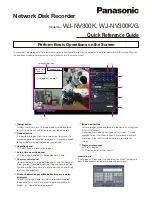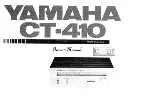
4. SEARCH/PRESET
The Search/Preset button scrolls between three different tuning
modes, each successive push of the button engages the next one
of the three modes.
a) Preset mode: In this mode you can use the Tune/Preset button
(No. 10) to select a Preset. When Preset Mode is selected
“PRESET” lights up in the display.
b) Search mode: By pressing the Tune/Preset button (10)
or
you can engage automatic tuning respectively up or down
the frequency band . The tuner will search automatically for
the first reasonably strong radio station, where it will stop.
Press the Tune/Preset button again to start searching again.
“SEARCH” lights up in the display. If a stereo station is received
“STEREO” will light up in red in the display, unless FM
Mute/Mode (No. 7) was engaged.
c) Tune mode: By pressing the Tune/Preset button (No. 10)
or
you can engage manual tuning respectively up or down
the frequency band for precise tuning to a specific frequency.
Keep either one of the Tune/Preset buttons pressed until you
are in the proximity of the desired frequency (use the
to
tune upwards in frequency;
for downwards tuning). With
each successive tap of the keys, the tuner will take 0.025MHz
steps on FM so you can accurately tune into the desired
frequency. For AM the tuning steps can be 9 kHz or 10 kHz,
depending on the version of your C440. This tuning mode can
also be useful when trying to receive a radio station which is
too weak for the Search mode. When tuned accurately to a
station, “>TUNED<” will light up in the display.
NOTE:
The Search/Preset buttons are also used in conjunction
with the Memory (No. 6) and Tune/Search (No. 10) buttons to
add and memorise user defined names to Presets. Refer to the
separate chapter “Storing, recalling and naming Presets” for more
information.
5. BLEND
Weak or remote stereo radio stations are sometimes received with
noise and hiss as the antenna signal is too weak. By switching the
tuner to mono will reduce the amount of noise and hiss but at the
expense of any stereo information. The NAD Blend feature will
allow you to reduce the amount noise and hiss but still retain
some level of stereo separation, instead of mono.
The Blend button toggles between engaging or disengaging the
Blend feature; when engaged, “BLEND” lights up in the display.
6. MEMORY
The Memory is used to store stations into the three Preset Memory
banks or to store user defined names for non-RDS Preset stations.
Used in conjunction with the Search/Preset (No.4) and
Tune/Preset (No. 10) buttons. When Memory is active, the Preset
number flashes and the red ‘MEMORY’ indicator is shown in the
Display Panel. Refer to the separate chapter “Storing, recalling
and naming Presets” for more information.
Note:
The 120V versions (North America) do not have RDS
(Radio Data System).
7. FM MUTE/MODE
This button combines two functions; it switches the tuner from
Stereo to Mono and disengages the muting circuitry at the same
time. The muting circuit will mute the tuner in between radio
stations when searching or tuning. This way the tuning noise is
avoided.
Very weak radio station signals however may be suppressed by the
muting circuit. if such a very weak station is in stereo it will have
a high level of background hiss. Switching to Mono Mode and
disengaging the muting circuit by depressing the FM MUTE/MODE
button will allow the station to be heard and will cancel most or
all of this background noise.
In normal operation the mute circuit is engaged, the display
indicates “FM MUTE”. Press the FM Mute/Mode button to
disengage the muting circuit and switch from stereo to mono
reception. “FM MUTE” in the display will extinguish. Press the FM
Mute/Mode switch again to return to Auto Stereo FM operation.
8. PS/RT (ON RDS VERSIONS ONLY)
With stations carrying RDS information, The PS/RT button scrolls
between three different display modes, each successive push of
the button engages the next one of the three modes:
a) In the default mode, the station’s RDS name is displayed,
Program Service (PS; normally the station’s calling letters, BBC
R3, for instance).
b) From the default mode, press the button once to view Radio
Text (RT). This can be additional information such as the
presenter’s or program’s name; what song is playing, etc. This
text scrolls continuously over the 8 alphanumeric display
segments. It takes a few seconds for the tuner to gather the RT
information, so immediately after tuning to a station and
selecting to view RT the display will indicate “WAIT” and
default to the station name.
c) Press the button from the display RT mode to display the
station frequency. Press again to return to the default mode
(a).
When tuned to a non-RDS station
The Display button toggles the display to show either the station
frequency or user entered station name. If no user name was
entered the display will just flash once.
NOTE:
The 120V versions (North America) do not have RDS
(Radio Data System)
8. DISPLAY (ON NON-RDS VERSIONS ONLY)
The Display button toggles the display to show either the station
frequency or user entered station name. If no user name was
entered the display will just flash once.
9. CHARACTER
The Character Button is used to enter the names of Preset radio
stations for display when the station is selected. Used together with
the Tune/Preset (No. 10) and MEMORY (No. 6) Buttons. Refer to
the separate chapter “Storing, recalling and naming Presets” for
more information.
GB
5
Summary of Contents for C440
Page 3: ...3 REAR PANEL CONNECTIONS FRONT PANEL CONTROLS ...
Page 13: ...F 13 ...
Page 27: ...I 27 ...
Page 33: ...P 33 ...































